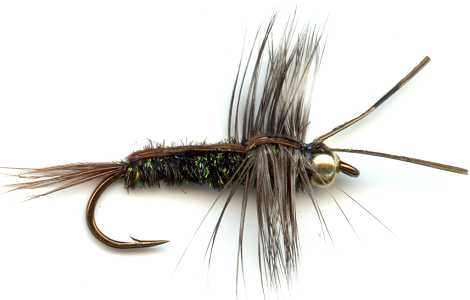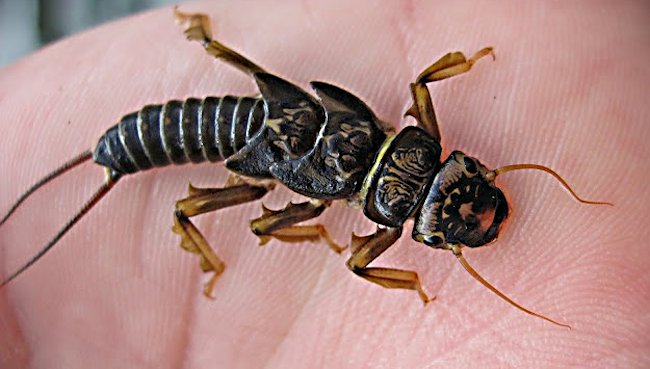The Half Back Stonefly Nymph
The stonefly (some times called a salmonfly, troutfly or willowfly) is available to trout in two stages: the nymph and the egg laying adult.

STONEFLY NYMPH FLY PATTERNS. Hook size 8 10 12 - $US each
THE HALFBACK STONEFLY NYMPH FLY PATTERN
The Halfback originated in the Black Hills of South Dakota and worked its way across
Southern Wyoming. Today it is used in all parts of North America and is
spreading across the world. Chris Reeves our fishing guide says, "Its a
cracking fly. It is my best catch everything pattern. It also works wonders in
South America. I prefer to use it in the bigger hook sizes. Its secret is that
it is so natural looking when they just hang in the water that the fish cannot
resist them."
Stonefly nymphs can normally be found in cool, well oxygenated, fast water and rapids that have stony or rocky bottoms. This is how they got their name 'stonefly'. However a few species have adapted to living in slower water with silt and weed. this is why they can also be found in still water, mainly near stony lake or reservoir shores. The Stonefly nymph is an important source of food for the trout and other fish. It cannot swim. This should be kept in mind when fishing. It spends it life crawling over the gravel and stony river and lake beds. They eat small invertebrate animals, decaying plant material, organic matter, algae and bacteria. They get oxygen from the water by diffusion or by means of external, feathery gill tufts. These may be present on the head, neck, or thorax. They prefer cold water as it holds more oxygen than warm water. They cannot survive in polluted water. As the nymphs grow they develop long tails at the end of their abdomen and segmented wing pads on their back. They can molt their skins up to 30 times and some species take up to 4 years to develop from egg to adult. Pale colored soft skinned nymphs that have just molted their skins are a particular attractive target for the local fish. As their shell hardens it darkens in color

The nymphs crawl from the water to hatch on land where they are safe from hungry fish. The trout follow them in their migration. They also crawl up overhanging vegetation, rocks and tree branches if they are available. Once out of the water they they pop out of their shuck and emerge as a winged adult. The adults look exactly like the nymphs except they have folded flat wings over their back when at rest. Some newly hatched adults try to fly too early and flutter down to the water surface a number of times before reaching land. This causes excitement on the water from the lurking predatory fish. They only become in danger of being fish food again when the females fly to the river to lay their eggs. Steelheads love munching on a stonefly nymph when they hatch mid to late winter. The Adult stone flies are weak fliers and seldom travel far from the water. They spend a great deal of their time just resting on rocks and vegetation. You can tell them apart from caddis adults by their split tail sticking out from under it's tight folded wing. Their lifespan as an adult varies from a few days to three months depending on the species. They mate on the ground, on rocks or on plants. The female lays hundreds of eggs in slimy masses by dipping their abdomen under the water or some species just drop them into the water whilst in flight.
There are over 500 different species of stoneflies in North America, 200 in Australia, but there are only about 30 species in Britain and of those only about 11 are of interest to the British fly-fisher. The others are either very rare or very localized in their distribution. Generally they have a large body size compared with other aquatic insects and are therefore an attractive meal to many fish. Fish them deep and animate them on the retrieve in front of where you think the fish are feeding. Historically Stoneflies were of sufficient importance to be mentioned in the ancient medieval British book on Fly fishing called the Treatysse. They were also described by the author and Georgian fly-fisherman Cotton in his book on fishing. After that they seemed to have fallen from favor in the nineteenth century. In Britain most of our stony river bed fast flowing waters are in the north of the country. During Victorian times and earlier it was the dry fly fishing craze on the southern lowland chalk streams and rivers that was important. As a consequence stonefly patterns were ignored in contemporary fishing books, newspaper articles and magazines. This is in contrast to North America where the abundance of rivers and streams that have stony bottoms have made the stonefly nymph an important fly to have in your fly box
If you are lucky enough to live, or go fishing in a salmon fishing area, from July onwards lookout for the red marked salmon lying in mid stream. It is salmon spawning time. It is not hard to locate trout or steelheads. Just look about three feet behind every pair of spawning salmon. The trout are fixed on eating salmon eggs that escape the gravel nest being made to keep the eggs safe. Egg patterns are a good choice but are not the only pattern to choose. Before spawning the salmon pair start digging a groove in the gravel of the river bed. This is called a 'redd'. This nest building activity disturbs and flushes out insects from the gravel. The trout are on the look out for disturbed stoneflies, mayfly nymphs and caddis larvae. If your egg patterns are not working because the fish are being very selective try a stonefly nymph. They will get you a good sized fish that you might not be able to fool with a traditional egg. If you are fishing water that allows the use of a dropper, try a stonefly nymph behind an egg pattern. The egg will get the trout's attention but you will be surprised how many reject the egg and go after the nymph. If the regulations do not allow this type of fishing I normally like to spot a good target fish. It may take about 15 drifts of the nymph in front of of the fish. Most feeding trout will eventually take the fly.
If the water is not clear following a rain storm and you cannot see your target fish you will have to read the water to try and find out the best place to cast your fly. Large areas of the river will hold no trout at all. Trout are usually solitary feeders and can normally be found next to something solid like a big boulder, patch of weeds, or the river bank. They lie up in stretches of the river where there is a high concentration of food. Look for creases on the water surface. These are lines that normally run downstream. They are caused by bodies of water, flowing at different rates, colliding. Trout food is concentrated in and around these creases. There is often slack water by the river bank and fast flowing water a few inches away. This is why a lot of trout can be found near the bank. Boulders and weedbeds cause the water to speed up to as they get past them. A crease is formed between the fast and slow water that traps floating aquatic insects in the eddies. Fish the crease and providing the trout are feeding you will catch fish.
As these nymphs cannot swim you need to get your artificial down to the bottom. Rather than using different weighted nymphs I like to use split shot onto the leader about four to five inches away from the fly. This allows the fly to move more naturally and tumble freely in the current unlike a heavily leaded pattern. Using an unleaded pattern also enables the fly to be slimmer and a more realistic shape. I cast upstream into all the likely spots such as fast ripples, slack creases, feed lanes and behind boulders. Non lead split shot alternatives are available if you fish in areas where the use of lead is prohibited.

